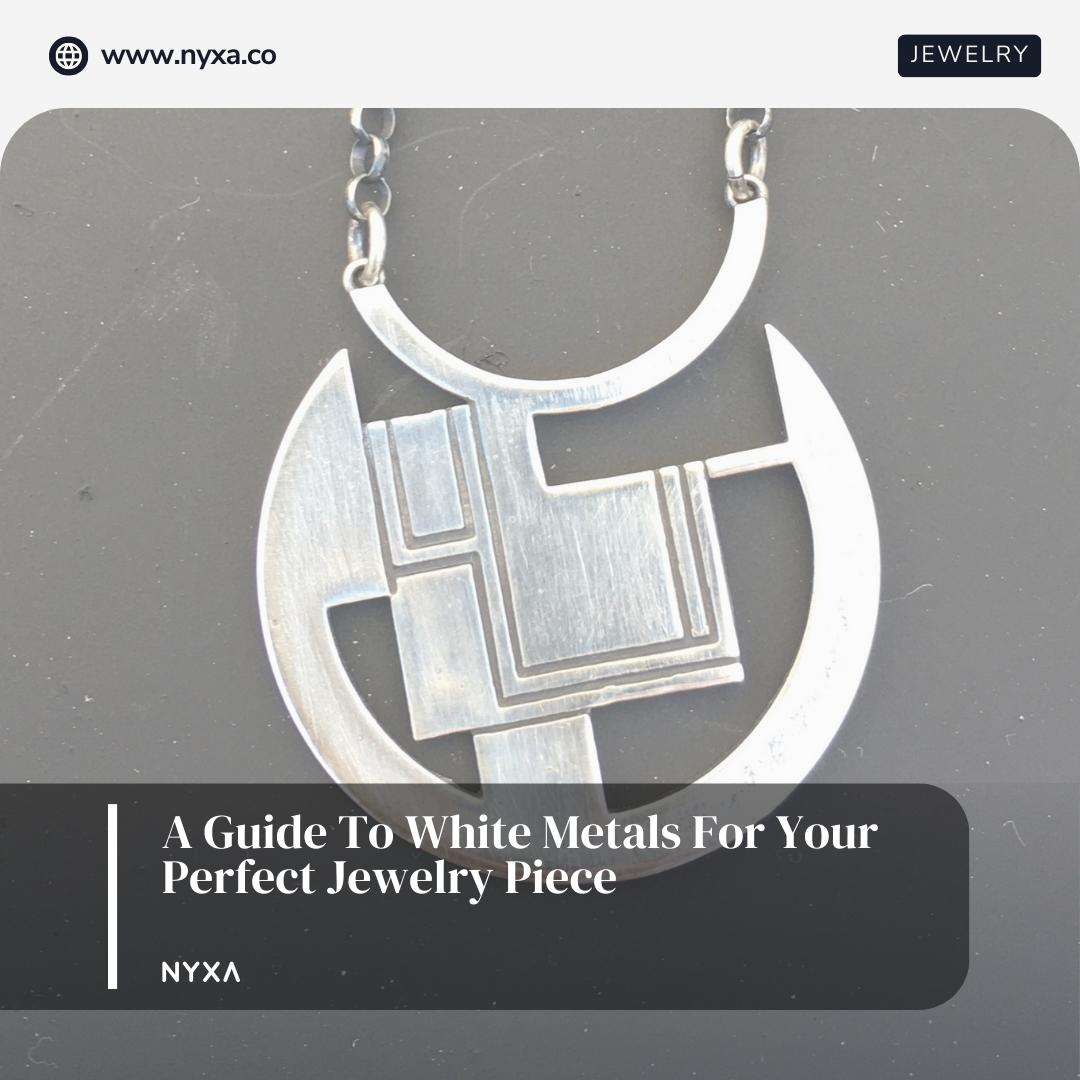
A Guide To White Metals For Your Perfect Jewelry Piece
Share
When choosing that perfect piece of jewelry, the spotlight often shines on design and style. However, the selection of precious metals is equally vital and can be a puzzle. This article aims to unravel the intricacies of white metals, shedding light on their unique properties, colors, and suitability for different lifestyles and budgets.

The Allure of White Metals
White metals have become the preferred choice for modern wedding and engagement rings. Their timeless silvery-white tones complement a variety of skin tones. Unlike yellow or rose metals exclusive to gold alloys, white metals offer a broader spectrum of options, each with its distinct hue and characteristics.
Understanding the Elements: Gold, Palladium, Platinum, Rhodium, and Silver
Gold, palladium, platinum, rhodium, and silver are individual elements on the periodic table, each possessing unique properties desirable for jewelry production. These properties influence factors such as alloy purity, metal density, and how the metal wears over time. Importantly, each precious metal is independently traded in the stock market, leading to price fluctuations based on supply and demand.

Deciding Factors: Maintenance, Density, and Price
Choosing the right white metal boils down to three critical factors: maintenance, density, and price. In this guide, we'll explore head-to-head matchups between four prominent white metals: White Gold, Platinum, Palladium, and Silver.
White Gold vs. Platinum vs. Palladium vs. Silver
White Gold vs. Platinum
White gold often boasts a lower price point than platinum. The primary reason for this lies in the composition, with platinum alloys containing 95% platinum, while white gold rings range from 58.5% to 75% gold content. Platinum is naturally more white and hypoallergenic. While white gold can be rhodium plated for a whiter finish, this requires extra maintenance over time.
Comparison Table:
| WHITE GOLD | PLATINUM |
|---|---|
| Lower Price | ✓ |
| Purity: 58.5% - 75% pure gold | 90-95% pure platinum |
| Whitest Color | ✓ |
| Hypoallergenic: Alloys containing Nickel are NOT hypoallergenic | ✓ |
| Maintenance: May require rhodium plating every 2 years | High-polished platinum will develop a worn patina over time |
White Gold vs. Palladium
Similar to platinum, palladium is hypoallergenic and naturally more white in color than white gold. It is also used at 95% purity. Palladium, however, is less dense, resulting in a lightweight feel for finished rings. Additionally, it is the most scratch-resistant among white metals.
Comparison Table:
| WHITE GOLD | PALLADIUM |
|---|---|
| Lower Price | ✓ |
| Purity: 58.5% - 75% pure gold | 90-95% pure palladium |
| Whitest Color | ✓ |
| Hypoallergenic: Alloys containing Nickel are NOT hypoallergenic | ✓ |
| Maintenance: May require rhodium plating every 2 years | More scratch-resistant |
Palladium vs. Platinum
Both palladium and platinum are platinum family metals, used at 95% purity. Palladium, being less dense, results in a lighter finished ring. Both metals are hypoallergenic, naturally white, and excellent for stone setting. The choice between them often hinges on factors such as weight and price.
Comparison Table:
| PALLADIUM | PLATINUM |
|---|---|
| Lower Price | ✓ |
| Purity: 90-95% pure platinum | 90-95% pure platinum |
| Whitest Color | ✓ |
| Hypoallergenic | ✓ |
| Maintenance: More scratch-resistant | High-polished platinum will develop a worn patina over time |
Silver vs. White Gold vs. Palladium vs. Platinum
Comparison Table:
| SILVER | WHITE GOLD | PALLADIUM | PLATINUM |
|---|---|---|---|
| Affordable Option | Lower Price | Lower Price | Highest Price |
| Purity: Typically 92.5% pure silver | Purity: 58.5% - 75% pure gold | Purity: 90-95% pure palladium | Purity: 90-95% pure platinum |
| Lustrous White Color | Whiter Color | Whiter Color | Whitest Color |
| May Tarnish Over Time | Hypoallergenic | Hypoallergenic | Hypoallergenic |
| Requires Regular Polishing | Maintenance: May require rhodium plating every 2 years | More scratch-resistant | High-polished platinum will develop a worn patina over time |
Rhodium Plating: Enhancing Whiteness
As explored in the Precious Metals Comparison For Fine Jewelry guide, many white gold alloys undergo rhodium plating. Rhodium, a precious metal from the platinum family, imparts a bright white color. However, this plating requires periodic reapplication, typically every 1 to 2 years, depending on the wearer's habits.

In the realm of white metals, the choice between white gold, platinum, palladium, and silver ultimately depends on individual preferences, lifestyle, and budget. Understanding the nuances of each metal empowers you to make an informed decision, ensuring your chosen jewelry aligns with your unique needs. For a full description of the different types of silver, please read The Ultimate Guide to Understanding Different Types of Silver Jewelry.
At NYXA, we craft genderless and size-inclusive 925 sterling silver jewelry, embodying innovation and sophistication. Explore our collection, of silver jewelry today.
Frequently Asked Questions
-
Q: How often does rhodium plating need to be reapplied?
- A: Rhodium plating typically needs reapplication every 1 to 2 years, varying based on the wearer's body chemistry and habits.
-
Q: What makes palladium more scratch-resistant?
- A: Palladium's lighter density contributes to its enhanced scratch resistance compared to other white metals.
-
Q: Why is platinum considered hypoallergenic?
- A: Platinum's hypoallergenic nature arises from its purity and lack of alloys containing allergenic materials like nickel.
-
Q: Can white gold be as white as platinum without rhodium plating?
- A: White gold may need rhodium plating to achieve a whiter finish, as platinum is naturally more white.
-
Q: How does silver compare to other white metals in terms of maintenance?
- A: Silver may tarnish over time and requires regular polishing to maintain its lustrous appearance, but many people prefer the oxidized silver look that happens from naturally tarnishing a piece of jewelry.
